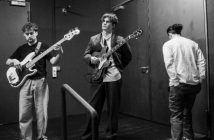Some really nice and unique playing by pianist Gabriela Montera and the BSO, but also some unusual and clumsy moments which did not quite work.
-
6
The Lighthouse, Poole, was host to an exuberant and enjoyable concert of quintessential orchestral repertoire, as it directed its spotlight onto the compositions and orchestrations of Maurice Ravel for “Picture Perfect” on the 7th of March. Conducted by the lively Carlos Miguel Prieto, the Bournemouth Symphony Orchestra guided its audience through the seductive textures and enticing energy of Ravel’s Rhapsodie Espanole, Debussy’s Danse-Tarantelle Styrienne, Ravel’s Piano Concerto in G Major and Mussorgsky’s epic, Pictures at an Exhibition. The concerto soloist was Gabriela Montero, an international pianist known for her personal and spirited approach to musical expressivity, making her BSO debut.
Despite being a somewhat early work by Ravel, Rhapsodie Espanole is still filled with the orchestral colour associated with the composer, with certain fiery moments lending themselves to the idea of a matador skirting dextrously around a bull, to use an analogy matching the work’s Spanish influences. The recurring four note motif which opens the four movement work was beautifully and delicately handled by the BSO, with comparatively punchy moments foreshadowing the later dance elements. This is a refreshing change, as some interpretations can execute these punctuations quite limply.
Colourful percussion heightened a rhythmically exciting second movement as tambourines and castanets made frequent appearances through the swirling texture. The third movement treated the listener to a light and brightly conveyed bassoon solo within the framework of a habanera, whilst the final movement, following thematic echoes of previous movements, brought a crashing end to the work with a thick, thunderous sonority. The overall tension of the Rhapsodie was very carefully poised by Prieto and the orchestra, with only a few moments allowed to escalate forth with ecstatic force. This suppression emphasised the final movement which, with extended coda, was the release of the excitement which had been building.
Debussy’s Danse which followed was an excellent orchestral translation of the character presented in the original piano piece. Ravel’s orchestral writing is more sparing here, not repeating the extravagance of Rhapsodie, likely due to the fast, rhythmic material which Debussy expertly crafted into mirthful celebration. A particular moment of brilliance on the part of the BSO was the sweet oboe and mellow clarinet solos in succession, which wove a beautiful moment of space and clarity into an otherwise relentless narrative. The theme’s refrain was additionally well performed with joy before heralding in the close.
Gabriela Montero’s individual interpretation of Ravel’s G major piano concerto was filled with carefree expression and childlike glee in addition to the poignant passivity which inhabited the second movement. Montero made effective distinctions between the solo and background roles of the piano in this concerto, and her often exaggerated use of dynamics helped to shape certain echoing phrases in the first movement which other interpretations have left unheard. An innocent excitement pervaded the movement which was then contrasted with a summer-day solemnity as Montero articulated some of the more jazz influenced lines. Certainly, the occasional slip by Montero was easily forgiven as the audience was brought into the relaxed and engaging touch of the pianist. Particular moments led Montero to bring out an unusual voicing in denser piano sections, but this allowed the concerto to be heard almost anew.
The understated second movement was finely handled by the soloist who, with a maintained balance, avoided both overly passionate remarks and bland apathy. Rather the cantabile melody was exquisitely wrought, with just fleeting splashes of expressive rubato colouring the steady innocence of the rhythm. An initial lack of synchronisation between the soloist and orchestra was swiftly resolved and, once again, the oboe solo offered a subtle and exquisite singing line which warmly reflected Montero’s opening. The rhythmic drive of the final movement was accentuated by the near break-neck tempo at which it was taken. Here Montero enjoyed her full solo possibilities with cascading flourishes and expressive liberties. The clarinet, which usually bites through the air in this movement, was much more gleefully bright than raspy, which seemed appropriate for Montero’s laid-back approach to the concerto.
A virtuosic improvised encore on the theme of ‘Coronation Street’ was performed by the pianist following the concerto. This was where Montero’s talent and artistic zeal really came through. The humour of such a commonplace tune being spontaneously transformed into a piece with its roots in Bach and Scarlatti was comical enough, without the impromptu transition into a perfect Joplin ragtime pastiche. This was lapped up by the audience who seemed to enjoy this feat as much as Montero did.
Mussorgsky’s Pictures at an Exhibition brought the concert to a close with a creative plethora of musical characters imitating a variety of paintings in a gallery. The iconic Promenade was boldly emphasised by Ravel’s orchestration. The trumpet’s stately confidence in the opening was then skilfully transformed, in regular iterations throughout the work, by Mussorgsky’s intelligent writing. The nimble articulations in Gnomus were controlled with precision by the large and sharp gestures of Prieto with the interplay of orchestral colours balanced nicely. Some wonderfully expressive lamentations from the bassoon and saxophone in The Old Castle contrasted with the clear rhythmic twitterings of flutes in Tuileries, while a carefully calculated assessment of Bydlo clearly yielded the vision of a large clumsy cart, avoiding the dangerously easy trap of a lethargic lumbering.
Other highlights from this work included the lithe and chirping flute solo in The Ballet of the Chicks in their Shells, the obtrusive and affronting performance of The Market Place at Limoges by the full orchestra, and the antiphonal effect between the horns and brass which is not conveyed in recordings. This hugely diverse work was rounded off by a massive coda which coyly returned to the theme of Promenade for a clamorous close, with all performers in action and two sets of tubular bells at both sides of the orchestra chiming out their declaration.
The BSO and Prieto worked seamlessly to create the delicate and vibrant colours set out by Ravel and, with the additional compositional minds of Debussy and Mussorgsky, it was a concert not to miss. Montero’s obvious love for performing and improvisation resulted in an engaging playing style and a unique interpretation of the concerto. While some clumsiness and miscommunication on the parts of both soloist and orchestra dampened the concerto and Pictures slightly, this should not take away from what was otherwise an excellent evening.



